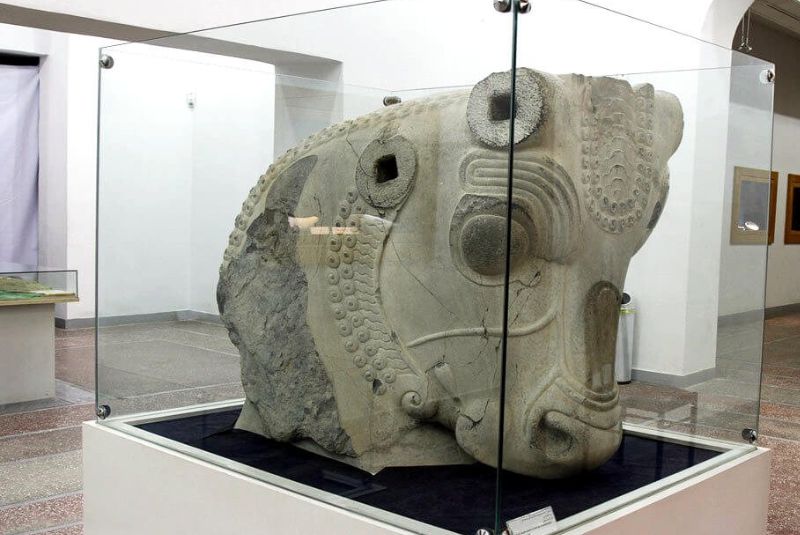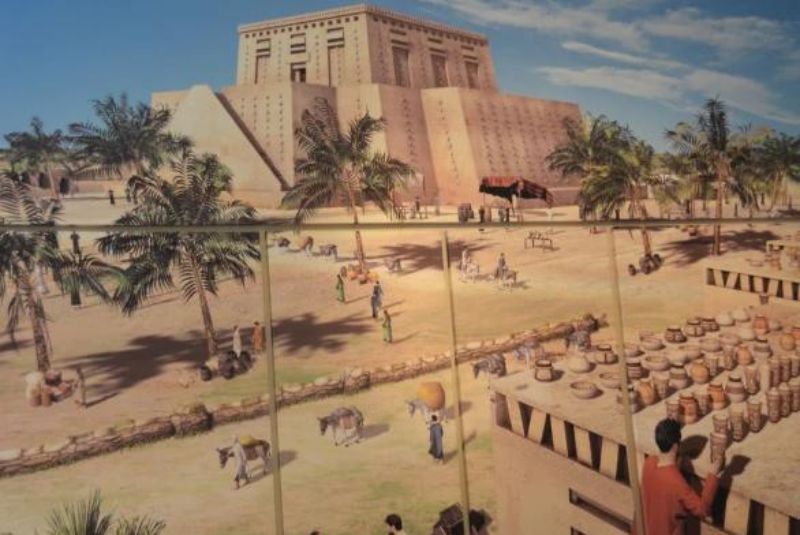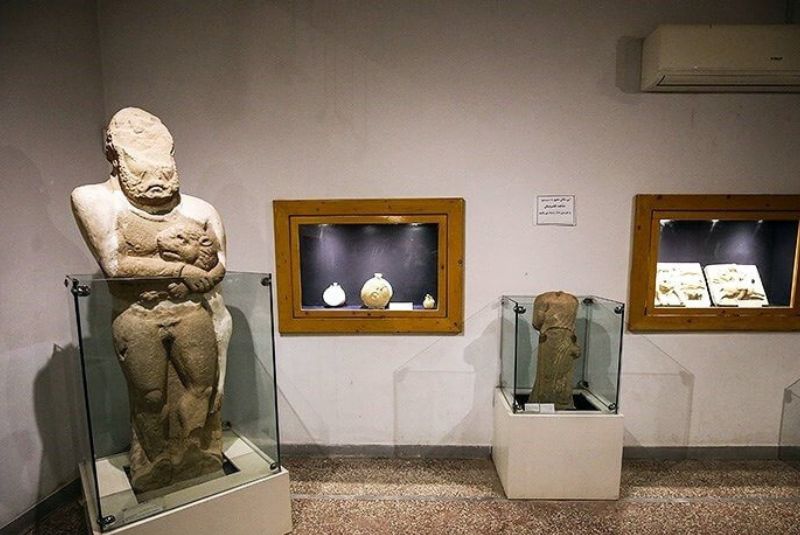Susa Museum | The One Museum You Don't Want to Miss
Susa is an ancient city dating back over 6000 years that served as a pivotal hub for civilizations such as the Proto-Elamite, Elamite, and Persian empires.
Renowned as one of Iran's premier museums of ancient artifacts, Susa (Shoosh) museum is situated near the ancient Shoosh Castle and boasts six exhibition halls showcasing artifacts spanning from the pre-Elamite to the Islamic period.
It showcases invaluable treasures from various historical periods, including relics from the six-millennia-old Susa civilization.
Exhibits range from the cow-headed diorite stela bearing the Laws of Hammurabi to discoveries from mosques in Shushtar and Apadana of Susa, offering a captivating journey through time.
Exploring the Susa Museum unveils not just artifacts, but a vibrant tapestry of Iran's ancient heritage. Follow us to learn more about the Susa Museum.
Why Visit the Susa Museum?

- This museum houses some of the most important treasures unearthed from the archaeological excavations of the city of Susa, making it the custodian of this city's heritage.
- It is situated next to the Susa Castle, known as the French Castle, originally the residence of French archaeologists who discovered the artifacts displayed in the museum.
- It is located alongside one of the world's most significant archaeological sites, the ancient Acropolis mound, which is also a UNESCO World Heritage Site.
- The Susa Museum holds a vast array of important artifacts discovered from the Acropolis mound.
| Also read about: Shushtar Hydraulic System - Ancient Engineering Wonder
About Susa Museum

The Susa Museum was established around half a century ago through the collaboration of the Khuzestan Governorate, a French archaeological team, and architects from the city of Dezful.
Its purpose is to display the artifacts uncovered during 160 years of archaeological excavations in Susa. The museum is situated in a large garden where some of Iran's significant historical artifacts, such as Achaemenid-era column capitals, are displayed in glass cases, visible even before entering the museum.
The museum features four interconnected halls, each showcasing artifacts from different historical periods, including Prehistoric, Elamite, Achaemenid, Parthian, and Islamic eras.
These artifacts come from Susa and other cities like Masjed Soleyman, Izeh, and archaeological sites such as the Acropolis mound, Haft Tapeh, and Bard-e-Neshandeh.
An interesting aspect of the Susa Museum is its location next to two notable historical sites: the Susa Castle and the ancient Acropolis mound. Additionally, parts of the museum's collection belong to the Acropolis archaeological site.
| Suggestion: Top 23 Museums in Iran + Photos
History of the Susa Museum

According to reports from the World Heritage Site of Susa, the idea to build the museum was proposed around 1962 at the request of the Governor of Khuzestan. He asked the renowned French archaeologist Roman Ghirshman to take on this responsibility.
After four years of construction, the Susa Museum was finally inaugurated on March 1, 1967 with two main halls. The architecture and construction were overseen by the Iranian architect Mohsen Foroughi.
During the eight years of the Iran-Iraq war, the museum was forced to close. However, a few years after the war ended, in 1998 , the museum building underwent renovation and expansion. Eventually, the Susa Museum reopened with four halls in 2006 .
The building covers an area of approximately 550 square meters and is situated in a garden of about 13,000 square meters. Interestingly, the bricks used for constructing the museum were originally excavated from the Acropolis and the archaeological site of Chogha Zanbil.
The building features a brick facade, and in front of the entrance, there is an octagonal pool adorned with blue glazed bricks. This, combined with the greenery of the garden, creates a beautiful ambiance for the museum.
| Discover: Bisotun (Behistun) - Rock Relief and Inscription of the Achaemenids
Different Sections of the Susa Museum

The Susa Museum consists of four halls that chronologically showcase the history from the inception of writing to the Hattians, Elamites, Achaemenids, Parthians, and Islamic periods. Let's explore the different sections of the museum.
Hall 1: Early Writing and Elamite Period
This hall features artifacts from two distinct periods: the beginning of writing and the Elamite era. These artifacts include a collection of small clay busts, pottery jars, and clay tablets with ancient scripts.
Notable Artifacts in Hall 1:
- Clay Bust of a Woman
- Date: Middle Elamite
- Discovery Location: Haft Tappeh, Susa
- Clay Boat
- Date: 4200 BCE
- Discovery Location: Susa
- Duck Weight Stone
- Date: 1000 BCE
- Discovery Location: Arjan, Behbahan
- Oil Lamp
- Date: Neo-Elamite
- Discovery Location: Susa
- Pottery Jug with Spout and Clay Lid
- Date: Early Writing (Late Susa II)
- Discovery Location: Acropolis Mound, Susa
- Clay Spindle Whorls
- Date: 4400-5500 BCE
- Discovery Location: Jafarabad and Susa
- Counting Balls
- Date: 3500-3200 BCE
- Discovery Location: Acropolis Mound, Susa
| Read more: Naqsh-e Rustam - Ancient Treasures & Zoroastrian Legacy
Hall 2: Achaemenid Empire
This hall displays artifacts from the glorious Achaemenid Empire. Most of these artifacts were uncovered during excavations in the ancient city of Susa. The hall houses some of the most fascinating items in the museum, such as large colored tablets depicting Achaemenid soldiers.
Notable Artifacts in Hall 2:
- Stone Column Base
- Date: Achaemenid
- Discovery Location: Susa
- Glazed Brick with Lotus Flower Design
- Date: Achaemenid
- Discovery Location: Susa
- Clay Gutters
- Date: Achaemenid
- Discovery Location: Susa
- Stone Catapult Balls
- Date: Achaemenid
- Discovery Location: Susa
- Sandstone Bull's Horn
- Date: Achaemenid
- Discovery Location: Susa
- Colorful Glazed Tiles of Soldiers and Winged Bulls
- Date: Achaemenid
- Discovery Location: Susa
Hall 3: Parthian Empire
In this hall, you will find artifacts from the Parthian Empire, many of which were discovered during excavations in the Susa area.
Notable Artifacts in Hall 3:
- Statue of Hercules
- Date: Parthian
- Discovery Location: Masjed Soleiman
- Parthian Capital
- Date: Parthian
- Discovery Location: Masjed Soleiman, Bard-e Neshandeh
- Headless Statue of a Woman
- Date: Parthian
- Discovery Location: Masjed Soleiman, Bard-e Neshandeh
- Capital with Two Back-to-Back Animals
- Date: Parthian
- Discovery Location: Masjed Soleiman, Bard-e Neshandeh
- Clay Bust of a Woman Influenced by Greek Style
- Date: Parthian
- Discovery Location: Masjed Soleiman, Bard-e Neshandeh
- Stone Necklaces
- Date: Parthian
- Discovery Location: Saleh Davood, Susa
| Also read about: Taq Bostan - Sassanid Rock Reliefs in Kermanshah, Iran
Hall 4 and Entrance Section: Achaemenid and Parthian Empires
Upon entering the museum, you will immediately encounter prominent artifacts from both the Achaemenid and Parthian periods in the entrance section. Hall 4, located to the right of the entrance, also displays a combination of selected pieces from these two eras.
Notable Artifacts in Hall 4 and Entrance Section:
- Massive Bull Capital (Apadana Palace)
- Date: Achaemenid
- Discovery Location: Susa
- Capital
- Date: Parthian
- Discovery Location: Masjed Soleiman, Bard-e Neshandeh
- Bell-Shaped Column Base with Cuneiform Inscription
- Date: Achaemenid
- Discovery Location: Susa
- Fragment of a Column
- Date: Parthian
- Discovery Location: Izeh
- Fire Altar
- Date: Achaemenid
- Discovery Location: Susa
Islamic Period
This hall features artifacts from the Islamic period in Susa and surrounding areas such as Dezful. The Islamic period artifacts include finely crafted pottery that represents the pinnacle of Islamic art in the region.
Other notable items from the Islamic period include bowls, oil lamps, and glazed jugs from the 9th to 12th centuries CE. Some of these artifacts are displayed in the museum courtyard.
| Suggestion: Pasargadae - Legacy of Cyrus the Great & Ancient City
Notable Islamic Period Artifacts:
- Stone Capital
- Date: Islamic (Zand-Qajar)
- Discovery Location: Vaziri Bath, Dezful
- Inscribed Stone Tablet in Kufic Script
- Date: Islamic
- Discovery Location: Susa
- Clay Jugs
- Date: Islamic
- Discovery Location: Susa
- Stone Tombstone Shaped like a Lion
- Date: Islamic (Probably Qajar)
- Discovery Location: Eastern Khuzestan
- Stone with Raised Plant Motifs
- Date: Islamic
- Discovery Location: Unknown
Facilities at the Shoosh Museum
- Restrooms
- Souvenir and handicrafts shop
- A room for screening educational films related to the museum
| Suggestion: Persepolis Ancient City - The Great Ancient Persian Capital
Ticket Prices for the Museum and Shoosh Castle

Since the museum and Shush Castle are located within the same complex, you need to pay the entrance fee for both attractions to enter the complex.
- Iranian Citizens: 3,000 Tomans
- Foreign Nationals: 20,000 Tomans
Shoosh Museum Opening Hours
The opening hours is from 8:00 AM to 7:00 PM
Susa Museum Location

The Susa Museum is located in Shush City, Khuzestan, Iran, on Imam Khomeini Boulevard. This museum, set within a historic complex that includes Shush Castle, offers visitors a deep dive into the region's rich archaeological heritage.
| Read more: Ivan Karkheh - The Largest Buried City of the Sassanid Empire
Shoosh Museum Nearby Attractions
- Tomb of Daniel - 500 meters walk
- Chogha Zanbil Ziggurat - 42.8 kilometers
- Ancient City of Susa - Next to the museum
- French Castle - Next to the museum
| Also might be interesting: Shahr-e Sukhte - The Beginning of Civilization in 3200 BC
Bottom Line
The Susa Museum offers a captivating journey through Iran's rich history, from the dawn of writing to the Islamic era. Located in the heart of Shush City, this museum not only showcases invaluable artifacts from various historical periods but also provides a serene environment for visitors to explore and reflect.
Here, you can marvel at artifacts ranging from ancient pottery and sculptures to monumental inscriptions and architectural fragments. The museum's location adjacent to significant historical sites, including the ancient city of Susa and the impressive Apadana Palace, enhances the experience, making it a must-visit for history enthusiasts and casual tourists alike.
Share your story!
Comment below and let us know about your Experience.
Your story inspires others!


Comment
Leave a Comment